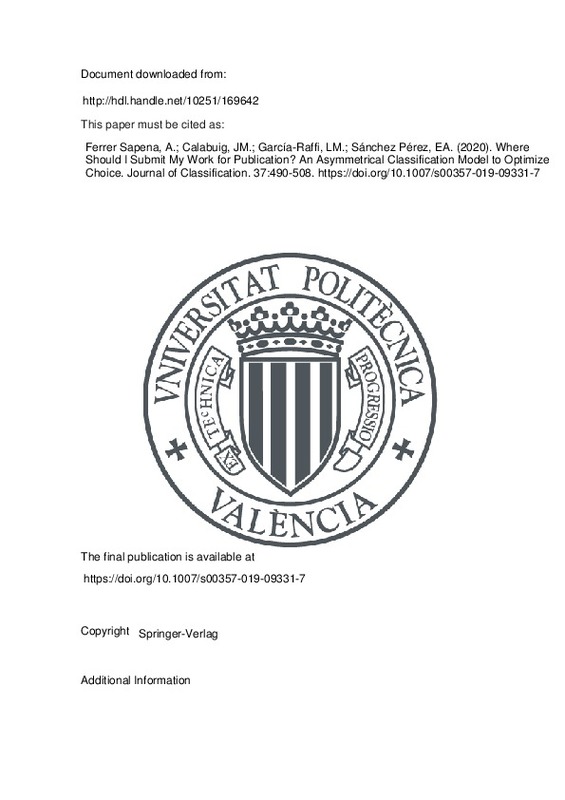Althouse, B.M., West, J.D., Bergstrom, C.T., Bergstrom, T. (2009). Differences in impact factor across fields and over time. Journal of the Association for Information Science and Technology, 60(1), 27–34.
Black, S. (2012). How much do core journals change over a decade? Library Resources and Technical Services, 56, 80–93.
Bradshaw, C.J., & Brook, B.W. (2016). How to rank journals. PloS One, 11 (3), e0149852.
[+]
Althouse, B.M., West, J.D., Bergstrom, C.T., Bergstrom, T. (2009). Differences in impact factor across fields and over time. Journal of the Association for Information Science and Technology, 60(1), 27–34.
Black, S. (2012). How much do core journals change over a decade? Library Resources and Technical Services, 56, 80–93.
Bradshaw, C.J., & Brook, B.W. (2016). How to rank journals. PloS One, 11 (3), e0149852.
Ferrer-Sapena, A., Diaz-Novillo, S., Sánchez-Pérez, E.A. (2017). Measuring time-dynamics and time-stability of Journal Rankings in Mathematics and Physics by Means of Fractional p-Variations. Publications, 5(3), 21.
Ferrer-Sapena, A., Sánchez-Pérez, E.A., González, L.M., Peset, F., Aleixandre-Benavent, R. (2015). Mathematical properties of weighted impact factors based on measures of prestige of the citing journals. Scientometrics, 105(3), 2089–2108.
Ferrer-Sapena, A., Sánchez-Pérez, E.A., González, L.M., Peset, F., Aleixandre-Benavent, R. (2016). The impact factor as a measuring tool of the prestige of the journals in research assessment in mathematics. Research Evaluation, 25(3), 306–314.
Gastel, B., & Day, R.A. (2016). How to write and publish a scientific paper. Santa Barbara: ABC-CLIO.
Gibbs, A. (2016). Improving publication: advice for busy higher education academics. International Journal for Academic Development, 21(3), 255–258.
Grabisch, M.M., Marichal, J.L., Mesiar, R., Pap, E. (2009). Aggregation functions. Cambridge: Cambridge University Press.
Haghdoost, A., Zare, M., Bazrafshan, A. (2014). How variable are the journal impact measures?. Online Information Review, 38, 723–737.
Hol, E.M. (2013). Empirical studies on volatility in international stock markets. Berlin: Springer.
Kelly, J.L. Jr. (2011). A new interpretation of information rate. Manuscript. Reprinted in: The Kelly capital growth investment criterion: theory and practice (pp. 25–34).
Klement, E.P., Mesiar, R., Pap, E. (2000). Triangular norms. Dordrecht/Boston/London: Kluwer Academic Publishers.
Klement, E.P., Mesiar, R., Pap, E. (2001). Uniform approximation of associative copulas by strict and non-strict copulas. Illinois Journal of Mathematics, 45 (4), 1393–1400.
Lawrence, P.A. (2003). The politics of publication. Nature, 422(6929), 259–261.
Lu, J., Wu, D., Mao, M., Wang, W., Zhang, G. (2015). Recommender system application developments: a survey. Decision Support Systems, 74, 12–32.
Mansilla, R., Köppen, E., Cocho, G., Miramontes, P. (2007). On the behavior of journal impact factor rank-order distribution. Journal of Informetrics, 1, 155–160.
Murtagh, F., Orlov, M., Mirkin, B. (2018). Qualitative judgement of research impact: Domain taxonomy as a fundamental framework for judgement of the quality of research. Journal of Classification, 35, 5–28.
Neff, B.D., & Olden, J.D. (2010). Not so fast: inflation in impact factors contributes to apparent improvements in journal quality. BioScience, 60(6), 455–459.
Nelsen, R.B. (1999). An introduction to copulas. New York: Springer.
Pajić, D. (2015). On the stability of citation-based journal rankings. Journal of Informetric, 9, 990–1006.
Shannon, C.E. (1948). A mathematical theory of communication. The Bell System Technical Journal, 27, 379–423. Reprinted in: ACM SIGMOBILE Mobile Computing and Communications Review, 5(1)(2001), 3-55.
Xu, H., Martin, E., Mahidadia, A. (2014). Contents and time sensitive document ranking of scientific literature. Journal of Informetrics, 8, 546–561.
[-]







![[Cerrado]](/themes/UPV/images/candado.png)


